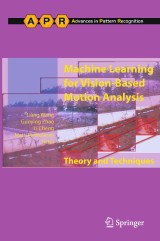Details

Machine Learning for Vision-Based Motion Analysis
Theory and TechniquesAdvances in Computer Vision and Pattern Recognition
|
149,79 € |
|
| Verlag: | Springer |
| Format: | |
| Veröffentl.: | 18.11.2010 |
| ISBN/EAN: | 9780857290571 |
| Sprache: | englisch |
| Anzahl Seiten: | 372 |
Dieses eBook enthält ein Wasserzeichen.
Beschreibungen
<p>Techniques of vision-based motion analysis aim to detect, track, identify, and generally understand the behavior of objects in image sequences. With the growth of video data in a wide range of applications from visual surveillance to human-machine interfaces, the ability to automatically analyze and understand object motions from video footage is of increasing importance. Among the latest developments in this field is the application of statistical machine learning algorithms for object tracking, activity modeling, and recognition.</p><p>Developed from expert contributions to the first and second International Workshop on Machine Learning for Vision-Based Motion Analysis, this important text/reference highlights the latest algorithms and systems for robust and effective vision-based motion understanding from a machine learning perspective. Highlighting the benefits of collaboration between the communities of object motion understanding and machine learning, the book discusses the most active forefronts of research, including current challenges and potential future directions.</p><p>Topics and features: provides a comprehensive review of the latest developments in vision-based motion analysis, presenting numerous case studies on state-of-the-art learning algorithms; examines algorithms for clustering and segmentation, and manifold learning for dynamical models; describes the theory behind mixed-state statistical models, with a focus on mixed-state Markov models that take into account spatial and temporal interaction; discusses object tracking in surveillance image streams, discriminative multiple target tracking, and guidewire tracking in fluoroscopy; explores issues of modeling for saliency detection, human gait modeling, modeling of extremely crowded scenes, and behavior modeling from video surveillance data; investigates methods for automatic recognition of gestures in Sign Language, and human action recognition from small training sets.</p><p>Researchers, professional engineers, and graduate students in computer vision, pattern recognition and machine learning, will all find this text an accessible survey of machine learning techniques for vision-based motion analysis. The book will also be of interest to all who work with specific vision applications, such as surveillance, sport event analysis, healthcare, video conferencing, and motion video indexing and retrieval.</p>
Part I: Manifold Learning and Clustering/Segmentation.- Practical Algorithms of Spectral Clustering: Toward Large-Scale Vision-Based Motion Analysis.- Riemannian Manifold Clustering and Dimensionality Reduction for Vision-based Analysis.- Manifold Learning for Multi-dimensional Auto-regressive Dynamical Models.- Part II: Tracking.- Mixed-state Markov Models in Image Motion Analysis.- Learning to Detect Event Sequences in Surveillance Streams at Very Low Frame Rate.- Discriminative Multiple Target Tracking.- A Framework of Wire Tracking in Image Guided Interventions.- Part III: Motion Analysis and Behavior Modeling.- An Integrated Approach to Visual Attention Modeling for Saliency Detection in Videos.- Video-based Human Motion Estimation by Part-whole Gait Manifold Learning.- Spatio-temporal Motion Pattern Models of Extremely Crowded Scenes.- Learning Behavioral Patterns of Time Series for Video-surveillance.- Part IV: Gesture and Action Recognition.- Recognition of Spatiotemporal Gestures in Sign Language using Gesture Threshold HMMs.- Learning Transferable Distance Functions for Human Action Recognition.
<p>Techniques of vision-based motion analysis aim to detect, track, identify, and generally understand the behavior of objects in image sequences. With the growth of video data in a wide range of applications from visual surveillance to human-machine interfaces, the ability to automatically analyze and understand object motions from video footage is of increasing importance. Among the latest developments in this field is the application of statistical machine learning algorithms for object tracking, activity modeling, and recognition.</p><p>Developed from expert contributions to the first and second International Workshop on Machine Learning for Vision-Based Motion Analysis, this important text/reference highlights the latest algorithms and systems for robust and effective vision-based motion understanding from a machine learning perspective. Highlighting the benefits of collaboration between the communities of object motion understanding and machine learning, the book discusses the most active forefronts of research, including current challenges and potential future directions.</p><p><b>Topics and features:</b></p><ul><li>Provides a comprehensive review of the latest developments in vision-based motion analysis, presenting numerous case studies on state-of-the-art learning algorithms</li><li>Examines algorithms for clustering and segmentation, and manifold learning for dynamical models</li><li>Describes the theory behind mixed-state statistical models, with a focus on mixed-state Markov models that take into account spatial and temporal interaction</li><li>Discusses object tracking in surveillance image streams, discriminative multiple target tracking, and guidewire tracking in fluoroscopy</li><li>Explores issues of modeling for saliency detection, human gait modeling, modeling of extremely crowded scenes, and behavior modeling from video surveillance data</li><li>Investigates methods for automatic recognition of gestures in Sign Language, and human action recognition from small training sets</li></ul><p>Researchers, professional engineers, and graduate students in computer vision, pattern recognition and machine learning, will all find this text an accessible survey of machine learning techniques for vision-based motion analysis. The book will also be of interest to all who work with specific vision applications, such as surveillance, sport event analysis, healthcare, video conferencing, and motion video indexing and retrieval.</p><p><b>Dr. Liang Wang</b> is a lecturer at the Department of Computer Science at the University of Bath, UK, and is also affiliated to the National Laboratory of Pattern Recognition in Beijing, China. <b>Dr. Guoying Zhao</b> is an adjunct professor at the Department of Electrical and Information Engineering at the University of Oulu, Finland. <b>Dr. Li Cheng</b> is a research scientist at the Agency for Science, Technology and Research (A*STAR), Singapore. <b>Dr. Matti Pietikäinen</b> is Professor of Information Technology at the Department of Electrical and Information Engineering at the University of Oulu, Finland.</p>
Provides a comprehensive and accessible review of vision-based motion analysis Highlights the latest algorithms and systems for robust and effective vision-based motion understanding from a machine learning perspective Describes the benefits of collaboration between the communities of object motion understanding and machine learning Includes supplementary material: sn.pub/extras
Diese Produkte könnten Sie auch interessieren:

Mixed-Signal Layout Generation Concepts

von: Chieh Lin, Arthur H.M. van Roermund, Domine Leenaerts

96,29 €

System-Level Design Techniques for Energy-Efficient Embedded Systems

von: Marcus T. Schmitz, Bashir M. Al-Hashimi, Petru Eles

96,29 €














